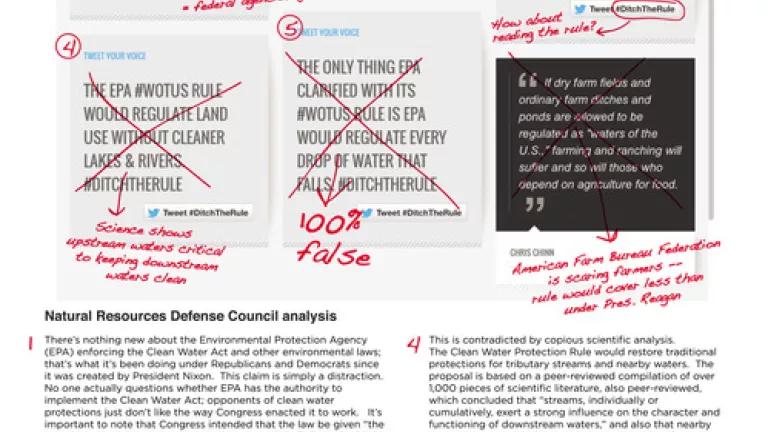
About eight years ago, several industry lobby groups, including the American Farm Bureau Federation, asked the Supreme Court to gut the Clean Water Act. The American Farm Bureau Federation specifically argued that Clean Water Act safeguards didn’t extend to streams that you can’t float a boat on (plus waters that had previously been navigable or could be made to be navigable), or to the wetlands nearby, even though such water bodies had long been included within the Act’s various pollution control programs. The waterways that they targeted are enormously important; those streams help supply drinking water for 117 million Americans, and wetlands filter pollution and trap flood water.
Although the Supreme Court refused to eviscerate the law, the attacks were partially successful, because they spawned Court opinions and policies from the prior administration that have created enormous uncertainty about what the law protects, and that made it more difficult and time-consuming to adequately prevent and remedy pollution of a variety of long-protected water bodies.
Now that the Obama administration has proposed its Clean Water Protection Rule to partially undo this rollback and restore full and clear protections to scores of critical waters now in legal limbo, the American Farm Bureau Federation is back on the attack. The problem is that it is peddling a bunch of misleading or entirely false claims.
To help sort out the truth, we’ve produced the graphic above, which analyzes some of AFBF’s myths. The myths discussed here are all in the form of tweets that the American Farm Bureau Federation is asking people to send as part of its campaign against the rule.
Why does it matter what misinformation an organization that has publicly fought to weaken the Clean Water Act is spreading about the Clean Water Protection Rule? Because some media outlets have reported these claims as fact and because a number of Senators and Representatives are echoing these arguments while pushing legislation that would kill the proposed rule. You’ll see some of the most outrageous examples debunked in this Media Matters post. There’s a real danger that this commonsense – and very restrained – proposal will be undone by these misleading attacks.
It also matters because this sadly isn’t the first time we’ve seen this cynical strategy used to undermine attempts to restore protections to the nation’s waters. Back in the late ‘00s, several leaders in Congress developed legislation called the Clean Water Restoration Act to reaffirm the traditional protections of the Clean Water Act, and industry lobby groups (including the American Farm Bureau Federation) banded together to form a cryptically-named partnership called the “Waters Advocacy Coalition” to fight the initiative. A New York Times piece about the battle discussed their tactics then:
But a broad coalition of industries has often successfully lobbied to prevent the full Congress from voting on such proposals by telling farmers and small-business owners that the new legislation would permit the government to regulate rain puddles and small ponds and layer new regulations on how they dispose of waste.
“The game plan is to emphasize the scary possibilities,” said one member of the Waters Advocacy Coalition, which has fought the legislation and is supported by the American Farm Bureau Federation, the National Association of Home Builders and other groups representing industries affected by the Clean Water Act.
“If you can get Glenn Beck to say that government storm troopers are going to invade your property, farmers in the Midwest will light up their congressmen’s switchboards,” said the coalition member, who asked not to be identified because he thought his descriptions would anger other coalition participants. Mr. Beck, a conservative commentator on Fox News, spoke at length against the Clean Water Restoration Act in December.
And here we go again, though this time the attacks target a proposal that is far less inclusive than the legislation would have been. Indeed, NRDC and many of our partners believe that the rule needs to be strengthened in key respects. Even the agencies’ much more limited approach, however, hasn’t made a dent in clean water opponents’ over-the-top rhetoric.
That’s why we think it’s so important to look closely at these claims, and why we produced this infographic. But there are other great resources out there that I hope you will consider and make up your own mind. In particular, please read the rule – the actual text of the proposed rule is very brief and straightforward. EPA also recently put out a Q&A document that speaks to some of the claims that have been made about the rule, especially pertaining to agriculture.
Finally, if the American Farm Bureau Federal insists on continuing its wild accusations about the rule, then NRDC hereby offers to debate AFBF publicly on the rule. Let’s air the arguments face-to-face on whether it’s needed, is consistent with the law as the Supreme Court has interpreted it, goes far enough or too far, and what it would actually do.

